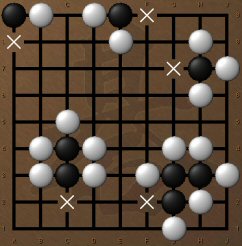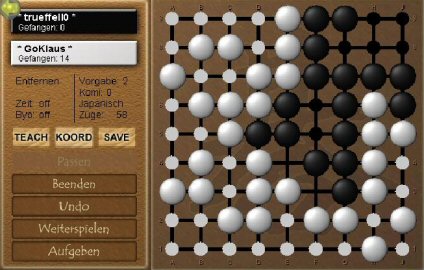Go
Game preparation
With /join 2 players can enter the game. With /start the game begins. Alternatively, you can use the game management use.
The game

The goal of the game is to enclose with its stones more area (free intersections) than the opponent.
The field

On the left of the Go Save there is the player ad: the player names and the stones beaten during the game are displayed above.
The buttons TEACH, KOORD and SAVE are exclusively for the mode thought.
Below the text buttons, the selected options are listed (see options).
The lower buttons are relevant to the player and will be explained below.
Game sequence
Set a stone
Players alternately place a stone of their color on any free intersection (exception: see suicide and co-regulation).
Freedoms of stones

The horizontal and vertical intersections directly adjacent to a stone are called freedoms. This also applies to groups, i.e. stones which are horizontally or vertically connected to one another (A-B or C-D-E).
Stroke of stones

If all freedoms are occupied by the opponent, the enclosed stone or the enclosed group is removed from the board. If a stone or a group has only one freedom, it stands in Atari.

This position arises after White has occupied the marked intersections.
suicide

It is forbidden to put stones in such a way that they are completely enclosed after the train, so that they no longer have freedoms; unless opposing stones are beaten, so that after the strike there are again freedoms. Black must therefore not set to the intersections marked with X.
Question:May White put on the marked field in the middle?

Yes, because by this train the eight black stones are beaten first. After that, even all adjacent intersections of the white stone are free.
Ko

When white with a set on A a black stone strikes, a so-called co, because the white stone is then itself Single also in Atari.

Ko means that immediately after the white train on A, black must not play on B, because otherwise a position repetition would occur. However, if still possible, black is allowed to play on B in the next train and would in turn open a co again on A. More on the page with the strategic tips.
Pass
Go has the opportunity to waive his right to train. A player can fit if he believes that further trains will no longer bring him any profit.
Playing

If the areas are completely demarcated and there is no way to make more points, both players fit.

After both players have fit, the computer marks the intersections (area points) that are completely enclosed by a color.

Now all the captive stones have to be removed by clicking from the board. As captive are stones whose impact can no longer be prevented.

If all captured stones are removed, then both players click "Finish" to confirm.
Undo/Next
If you accidentally click on a wrong stone when removing captive stones, you can reverse this with Undo. If the two players do not agree about the captured stones, then a player can click on Continue play. Then the original position will be restored and the player who first matched may play the first.
Report
Here in the BSW it is possible to give up the game at the earliest after 20 trains. The opponent wins with 20 points.
Billing

Now the areas of each player are billed. There is a point for each area (marked by a black or white point). In addition, the number of prisoners (battered stones) is added. Furthermore, the white player still gets the comi set before the start of the game, which (if positive) should compensate the suit advantage of the black player.
In the picture, Black has seven points in the area to the right, White has 28 points. There are now 14 prisoners for white and 0 prisoners for black. The intersections E4 and F3 are therefore not evaluated. The winner receives the difference of both results as a score, the loser gets zero points.
Options
listing
Sets the size of the board. 9x9, 13x13 and 19x19 are selectable.
Standard in the BSW is 9x9.
time
Limits the playing time per game and per player.
Adjustable are values between 1min and 60min. Intermediate values using /option time 12min
Defaulted.
byoyomi
Byoyomi is almost a grace period when playing with time limit. If the Byoyomi is set to X seconds, it enters into force as soon as the last X seconds of the set playing time (/time) are reached. If the player gets to take his train within the time X, he gets X seconds for the next train. If he does not, the game is over and the opponent wins with 20 points.
If the Byoyomi is set to zero seconds, this is a Sudden Death; i.e. as soon as the set playing time expires, the game ends immediately.
Values between 0sec and 60sec are adjustable. Intermediate values using /option byoyomi 15sec.
Defaulted.
handicap
Different levels of play can be compensated in the Go by means of a handicap. The weaker player gets a certain number of presets, depending on the difference in strength. The default stones are automatically set to the board by the computer. Then White starts the game.
Values between 0 and 9.
Defaulted.
Coming
Black starts in a lot without preset stones. White receives a certain number of points called Komi - as compensation for the suit advantage of black. The set number will later be charged with the scored points of the white player.
Adjustable via the game options are values from -6 to 9, arbitrary values by means of /option komi number.
Standard in the BSW is a comi of 6 points.
rule
For the evaluation of a Go-Party there are a whole range of evaluation variants worldwide. In the BSW, with small exceptions, the Japanese and the Chinese count are available. The Japanese rating is the standard setting and already described above under break.
In the case of the Chinese assessment, all areas and all the stones on the board are evaluated at the end of the game. In addition, white is also credited with the number of preset stones (if selected) and the set comi is calculated. Note that there are no neutral points in the normal case.
Related links
There is a good guide for Go, where you can learn Go step by step interactively. Another interesting page you will find here, but only in English and French.

